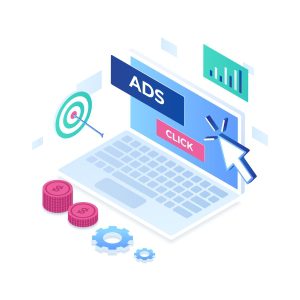
Strategies and Trends for Effective Digital Advertising
Every business, regardless of its niche or size, relies on marketing to build brand awareness, reach a target audience, foster customer relationships, and increase sales. But marketing is broad and relies on several networks, platforms, and systems. Digital advertising, for instance, is a form of marketing that is constantly evolving and proving to be quite effective when combined with other forms of digital marketing.
What is Digital Advertising?
Before a customer purchases a product or service, they often go through three critical stages, namely: the awareness stage, the consideration stage, and the decision stage. During these stages, they take their time to understand the business, the team behind it, and how that product or service stands out from the competition.
If a prospective customer doesn’t know of your product or service, you can bet they won’t consider you for business. Therefore, digital advertising plays a critical role in the awareness stage. It ensures that your product or service has a name in the market.
Digital or online advertising relies on various platforms such as social media, search engines, mobile apps, and websites to build brand awareness, engage audiences, and drive desired actions or conversions.
Digital Advertising vs. Digital Marketing

Many people use the phrases digital advertising and digital marketing interchangeably. And while the two are related, they mean two different things. Simply put, digital marketing is an umbrella term that encompasses all marketing efforts using digital platforms or channels. It involves various strategies and activities to promote business, build awareness, and drive conversations.
Digital marketing may include offline and online tactics such as Search engine optimization, email marketing, content marketing, social media marketing, influencer marketing, etc.
Digital advertising, however, is a subset of digital marketing, specifically focused on promoting products or services using online advertising channels. It often involves paid placements or ads designed to reach a specific target demographic.
Current Trends in Digital Advertising and Marketing
If you are keen enough, you have probably seen a steady change in how businesses advertise their products and services. These changes or trends are no accidents or coincidences. Rather, they are a result of careful adaptation to the evolving digital landscape and the ever-changing consumer behaviors.
Today, for instance, you will find personalized, five-seconds video ads instead of random 5-minutes videos. Ads are also becoming more dynamic, with some incorporating variables such as the current weather, location, or time of day to enhance the user experience and increase the effectiveness of advertising campaigns. Here are the other digital advertising trends to keep an eye on:
- Interactive ad formats: This is a technique where you involve users or viewers in the ad experience. Standard procedures include incorporating polls, quizzes, interactive videos, or mini-games to encourage user engagement and participation. Another advantage of interactive ads is that you can collect critical data and insights into the audience’s behaviors and preferences.
- Behavioral targeting: Random ads aren’t effective in engagement and conversion since they don’t speak to the interests and preferences of the target audience. By tracking online interactions and user actions, such as previous purchases, website visits, and search history, it’s possible to deliver personalized and more effective ads.
- Mobile dominance: The number of mobile users in 2023 is estimated at 6.8 billion, representing an average annual increase of 4.2%. These figures are pushing marketers to rethink their ad campaigns with a specific focus on optimizing them for mobile screens and utilizing mobile apps.
- Intelligent advertising: AI and automated algorithms are pushing the boundaries of what’s possible in digital marketing. Today, AI in digital marketing enables cost-efficient ad placement across multiple channels and allows for precise user targeting.
- AR and VR Integration: Several companies, such as IKEA, Adidas, and Volvo, increasingly embrace AR and VR technologies in their advertising campaigns to demonstrate products and provide virtual try-on experiences. These technologies increase engagement and boost conversion.
Ways of Advertising Online

Digital or online advertising comes in various forms. However, they are often categorized into two main groups: display ads and native ads. Display ads are the digital evolution of flyers and billboard ads. They feature an ad copy, images or graphics, and a CTA. Examples of display ads include:
- Popup ads: These are often considered very annoying since they interrupt browsing and require the user to take the specified action or manually close them. Popup ads are still in use, but there are ways you can make them less disruptive.
- Video ads: include video commercials, TV ads, and Facebook and YouTube ads. Modern video ads across social media channels are highly engaging, personalized, and interactive.
- Banner ads: These are image-based ads often displayed to the side or above the web content.
- Rich media ads: Rich media ads may feature text fields, scroll or swipe functionality, and even 360-degree rotatable images.
Native ads, on the other hand, are designed to blend seamlessly with the platform or content used. And as the name suggests, native ads should speak to the audience in a way that makes sense to them. Examples of native ads include:
- Paid search ads: As a website owner, you pay Google to rank your web pages on the first pages of the Google Search Results Pages (SERPs).
- Social media ads: You pay your favorite social media platforms, such as Facebook or Instagram, to get posts to rank higher in the platform’s algorithm and appear in the feeds of non-followers with similar browsing or shopping habits.
- Promoted listings: You pay a listing site to rank your business at the top of the platform’s search results page.
- Sponsored content: You sponsor a podcast or video, and the owner features your business or displays an ad letting the audience know about your business.
- Influencer partnership: You pay or partner with a social media influencer who creates awareness for your brand. This technique is powerful, but you need a solid influencer marketing strategy to make this work for your business.
Bottom Line
Now that you know how online advertising works, its examples, and its benefits, it’s time to put everything into action. Typically, you want to have a plan or strategy for how you’ll drive your digital advertising campaign.
This involves understanding your goals and KPIs and knowing your target audience, distribution channels, content materials, and budget. If you are new to digital marketing and online advertising, seek expert help from an experienced and reputable digital marketing firm.

The landscape of the Internet is ever changing and Nicole has the energy and aptitude to keep Stevens & Tate Marketing out in front of the pack. She leads an enthusiastic team in strategic planning, development, search engine marketing, online promotions and advertising for the web.





